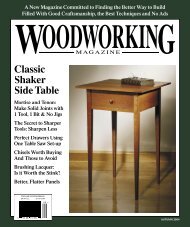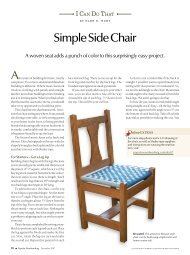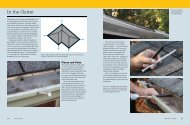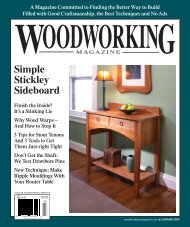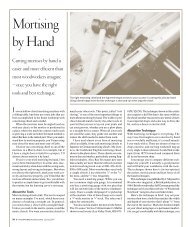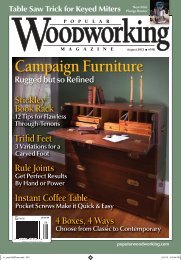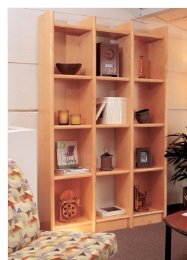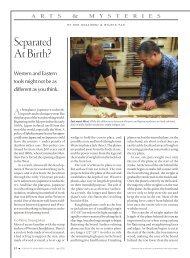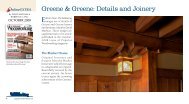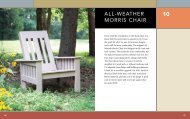Three Shaker Clocks - Popular Woodworking Magazine
Three Shaker Clocks - Popular Woodworking Magazine
Three Shaker Clocks - Popular Woodworking Magazine
You also want an ePaper? Increase the reach of your titles
YUMPU automatically turns print PDFs into web optimized ePapers that Google loves.
<strong>Shaker</strong> Tall <strong>Clocks</strong>A Family Project
The Story of <strong>Three</strong> <strong>Shaker</strong> <strong>Clocks</strong>For years my father Tom and I had been talking about doing a father/sonwoodworking project, but we just never got around to doing it. When hisprostate cancer relapsed and metastasized in 2007, my father decided the timewas right. We searched for <strong>Shaker</strong> clock designs, until we came across GlenHuey's plan in the August 2007 issue of <strong>Popular</strong> <strong>Woodworking</strong>. My sister Erinliked the clock, and the idea of a family woodworking project, so she decided tomake a clock as well.My father set about ordering the wood from a local store specializing inhardwood lumber. The hardware was ordered online along with the movements,stain, and a table saw jig for making cove molding. The clock faces were laterordered with our names printed on them, along with the year. Work on theclocks began in March of 2008. Over the next several months we transformedthe raw materials into three beautiful clocks equal in fit and finish to anythingfound in a high!end furniture store. We used virtually every tool in the shop,made plenty of mistakes along the way, and learned several new techniques; butthe end product is amazing. Words cannot adequately describe my satisfactionwith this project and the results. My father and I have much experience making
Cont.smaller items such as wooden toys, but have never made anything of thismagnitude. The feat is even more impressive for my sister. She has never donewoodworking before this project, yet her clock is equal in quality and beauty tothe other two. Her husband George was overseas supporting the U.S. e"orts inIraq, so she had to make time while being a single mom. For all three of us, thisproject has given us a lot. We each have a new family heirloom that is sure to bepassed down for generations to come. We now have the confidence that we cancomplete any woodworking project we decide to undertake. Most importantly,we built these clocks together, and every time we look at our clocks we will bereminded of the fun times we had working in the shop on this project.As my father's disease progressed, the shop #and this project$ became asanctuary ! a temporary escape. He was able to fi nish his clock first andcontinued to come down to the shop with us until just a few weeks before ourswere complete. This book documents the evolution of the clocks from the rawmaterials through the finished products. <strong>Three</strong> copies of the book were printedto ensure the story is passed down with each of the clocks.! Pat McCarty, 11/2008
The plans from which our clocks were crafted came from the August 2007 issue of <strong>Popular</strong> <strong>Woodworking</strong>.S2S Cherry lumber came from a local wood supply store.
As the lumber came finished only on two sides, we spent some time jointing, planing, and sanding the piecesbefore any joinery began. You can see Tom's left hand is wrapped ! a few weeks earlier he had a shop accidentwhen he inadvertently drilled into his little finger! The claw didn't slow him down, however...
The waists were assembled with glue and biscuits, then clamped with angle blocks to help keep them square.
Like the waists, the bases were joined with biscuits and glue.Once the bases were dry, adjustable feet were attached and the bases were screwed to the waists.
This picture was taken to send to George, who was able to receive email while in Kuwait.Connor is holding the sign he made for his father.
On the left, the waists after a light sanding.On the right, a few of the waists with the bases attached.Up next ! cove molding.
Hardwood #especially Cherry$ molding is extremely di%cult to find, so we made our own from scratch.Here we're using a jig to produce cove molding on the table saw.It worked well, but running wood diagonally across the sawblade just doesn't seem right!
The tops of the clocks, the "hoods", are assembled and glued separately.They do not permanently attach to the waist ! the appearance of a one piece clock is an illusion.
Here you can see clocks with the bases complete, cove molding attached, and one of the hoods sitting on top.At this point the clocks are really starting to take shape!
Here's Tom turning at the lathe. Each hood contains three identical turnings.One is glued with craft paper, turned, then split into two to form the half!round back columns.Tom and Erin both had an easier time with this than I did ! turning is _not_ one of my strengths in the shop.
At left, the hood with the turnings installed.With the turnings finished, the next step was to create the dial frame and the hood door.Arches on both were cut on the bandsaw and cleaned up with the oscillating spindle sander.
The arch frame is made with half!lap joints.Stock is removed using the table saw to nibble away stock one "kerf" at a time.This is a slow procedure but works well.
The four pieces that from the arch dial are glued.The half!lap joints provide a lot of gluing surface so no nails, biscuits, or screws are needed.
With the addition of the doors, the hoods are complete.Finally!The hoods are the most complex part of the clocks, and took the most time to create.
With the hoods complete, the next steps were to create and assemble the waist door and the "seatboards" forthe Kienninger movements. We also made little wooden holders for the winding keys, which you can see onthe left being clamped to the door while the glue sets. Here I am watching the glue dry...
The movements were mounted to the seatboards and the clock faces were added, along with the hands.The faces are held fast by a dab of hot!metal glue in the corners, and keyhole grommets are tapped into theholes by a mallet.
With the movements installed, it's time to dry fit the hood.The end is finally in sight!
Here Tom is making final adjustments to one of the waist doors.Getting doors to fit properly with the hinges is deceptively di%cult to do.In this case, a binding door was removed and the hinge mortises deepened.
Final dry!fitting of my clock prior to the finish being applied. Keyhole grommets, though not called for in theplan, add a nice finish and help hold the paper face flat. The grommets were procured from a local clock shop.The grommets were a dollar, but the half!hour clock!movement lesson I got from the store owner was free!
<strong>Clocks</strong> were finished in three steps. A sanding sealer helps to reduce the blotching inherent in Cherry.At left, you can see how the sealer brings out the color of the wood.After the sealer we stained the wood with Cherry Danish Oil.
Erin applied an extra coat of the Danish Oil to her clock for a darker color.After the oil, the clocks received two coats of lacquer, sanded smooth after each coat with fine steel wool.
Here's our three clocks together.Slight di"erences in the finish, clock face, and woodwork give each clock a little bit of unique character.They're all beautiful!
Here we are with our father's clock in the background.
Clock InfoClock Design: Glen Huey, <strong>Popular</strong> <strong>Woodworking</strong> 8/2007Primary Wood: American CherrySecondary Wood: Poplar ! used for seatboard, baseboard, and backerboardsClock Face: Sourced from ClockPrints.Com #CL14 <strong>Shaker</strong> II 11"x17"$Clock Hardware: Horton BrassesMovement: Kienninger 8!day cable!driven, gong strike, from Merritts.ComFinish: Shellac/Alcohol sanding sealer, Cherry Danish Oil, dull!rubbed lacquer<strong>Three</strong> clocks made by:Thomas McCarty #Waterford, CT$Erin Kuenneke #Waterford, CT$Patrick McCarty #PeaceDale, RI$Clockmaking support provided by Brenda McCarty #emotional support,photography, feeding us, finishwork$ ! Thanks Mom!



